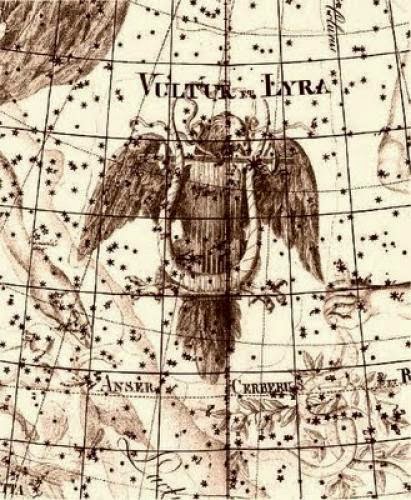
The lyre got Hermes out of trouble after a youthful exploit in which he stole some of Apollo's cattle. Apollo angrily came to demand their return, but when he heard the beautiful music of the lyre he let Hermes keep the cattle and took the lyre in exchange. Eratosthenes says that Apollo later gave the lyre to Orpheus to accompany his songs.
Orpheus was the greatest musician of his age, able to charm rocks and streams with the magic of his songs. He was even reputed to have attracted rows of oak trees down to the coast of Thrace with the music of his lyre. Orpheus joined the expedition of Jason and the Argonauts in search of the golden fleece. When the Argonauts heard the tempting song of the Sirens, sea nymphs who had lured generations of sailors to destruction, Orpheus sang a counter melody that drowned the Sirens' voices.
Later, Orpheus married the nymph Eurydice. One day, Eurydice was spied by Aristaeus, a son of Apollo, who attacked her in a fit of passion. Fleeing from him, she stepped on a snake and died from its poisonous bite. Orpheus was heartbroken; unable to live without his young wife, Orpheus descended into the Underworld to plead for her release. Such a request was unprecedented. But the sound of his music charmed even the cold heart of Hades, god of the Underworld, who finally agreed to let Eurydice accompany Orpheus back to the land of the living on one solemn condition: Orpheus must not at any stage look behind him until the couple were safely back in daylight.
Orpheus readily accepted, and led Eurydice through the dark passage that led to the upper world, strumming his lyre to guide her. It was an unnerving feeling to be followed by a ghost. He could never be quite sure that his beloved was following, but he dared not look back. Eventually, as they approached the surface, his nerve gave out. He turned around to confirm that Eurydice was still there - and at that moment she slipped back into the depths of the Underworld, out of his grasp for ever.
Orpheus was inconsolable. He wandered the countryside, plaintively playing his lyre. Many women offered themselves to the great musician in marriage, but he preferred the company of young boys.
There are two accounts of the death of Orpheus. One version, told by Ovid in his Metamorphoses, says that the local women, offended at being rejected by Orpheus, ganged up on him as he sat singing one day. They began to throw rocks and spears at him. At first his music charmed the weapons so that they fell harmlessly at his feet, but the women raised such a din that they eventually drowned the magic music and the missiles found their mark.
Eratosthenes, on the other hand, says that Orpheus incurred the wrath of the god Dionysus by not making sacrifices to him. Orpheus regarded Apollo, the Sun god, as the supreme deity and would often sit on the summit of Mount Pangaeum awaiting dawn so that he could be the first to salute the Sun with his melodies. In retribution for this snub, Dionysus sent his manic followers to tear Orpheus limb from limb. Either way, Orpheus finally joined his beloved Eurydice in the Underworld, while the muses put the lyre among the stars with the approval of Zeus, their father.
Ptolemy knew the constellation's brightest star simply as Lyra. The name we use for this star today, Vega, comes from the Arabic words al-nasr al-waqi' that can mean either 'the swooping eagle' or 'vulture', for the Arabs saw an eagle or vulture here. The constellation was often depicted on star maps as a bird positioned behind a lyre, as on the illustration above. It seems that the Arabs visualized Vega and its two nearby stars Epsilon and Zeta Lyrae as an eagle with folded wings, swooping down in its prey, whereas in the nearby constellation Aquila the star Altair and its two attendant stars gave the impression of a flying eagle with wings outstretched.
Beta Lyrae is called Sheliak, a name that comes from the Arabic for 'harp', in reference to the constellation as a whole. Beta Lyrae is a celebrated variable star. Gamma Lyrae is called Sulafat, from the Arabic meaning 'the tortoise', after the animal from whose shell Hermes made the lyre. Between Beta and Gamma Lyrae lies the Ring Nebula, often pictured in astronomy books; it is a shell of gas thrown off by a dying star.
(c) Ian Ridpath. All rights reserved
Visit Ian Ridpath's Star Tales website
Star Tales
by
Ian Ridpath
ISBN-10: 0876636946
ISBN-13: 978-0876636947


















